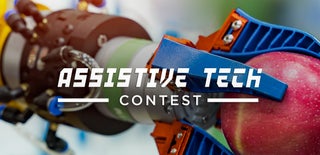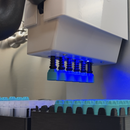Introduction: CardiaCARE - Cardiac Rehab Fall Detector/ECG Case
I noticed the Assistive Tech Contest and decided I'd try and make something near and dear to my heart (sorry...terrible pun).
Being 33 years old I am not exactly what you might expect as a typical cardiac rehab patient.
Unfortunately, I was a cardiac rehab patient and during a 6 month stint I kept running into one major problem: I was losing consciousness while working out.
I suffer from an autonomic nervous system disorder called Postural Orthostatic Tachycardia Syndrome (POTS) which causes blood to pool in my legs while in an upright or standing position. When this blood pools I don't receive an adequate amount of blood supply back to my heart (and as a result...my brain doesn't receive enough either). When someone continues to have poor blood flow to the brain like this there are two things that can happen:
1. They can lie down to help the heart pump oxygenated blood back to the brain normally.
or
2. Their body forces them to lie down by fainting.
As you can imagine, fainting when exercising poses a lot of risks. It is also creates challenges in a cardiac rehab program as nurses need to monitor other patients simultaneously.
To help address some of these issues I developed a concept device called cardiaCARE, a fall detector/ECG case designed to allow easier access for taking vitals, prevent neck injuries, and alert staff to falls.
In the picture above, you can see an example of what is traditionally used to hold monitors during cardiac rehab: a small pouch that loops around the neck to hold an ECG and wires.
One of the issues with these pouches is that ECG wires have to be fed through the top of the shirt which leaves both the pouch strap and wires exposed and swinging freely. This is not only uncomfortable for patients who are exercising, it also makes it difficult for staff to move wires out of the way to take blood pressure, oxygen levels, and other vitals while a patient is working out.
Another issue I am hoping to eliminate is potential neck injuries and/or choking hazards posed by pouches. With so many handles, dials, and knobs in a gym, these pouches create a serious risk of catching and hooking onto an object if a person falls or passes out. This is something that actually happened to me once when I passed out on a recumbent bike and my pouch got snagged on a side handle. For this, I designed a clip-on attachment for the waist so an EKG monitor can be stored off of the neck and allow wires to be fed up underneath the shirt out of the way of both patients and nurses.
Finally, I added an ultrasonic sensor with an attached piezo buzzer to alert staff in case a patient falls. There are other options which are probably better suited for detecting falls, but I merely wanted to design a proof of concept prototype for this contest. When the sensor is within 6 inches of the ground the piezo buzzer will sound to alert staff of a fall. While not all patients may have the same risk of fainting like I do, the typical makeup of a cardiac rehab program is predominately elderly individuals. Fall risks among this patient population are very real and do occasionally happen. I feel development on this aspect of the device is extremely important and worth exploring further.
This entire design was made solely in TinkerCAD and features an upper container area with a lid that can store a 3-lead ECG monitor. Underneath the upper container is a compartment which contains a 9V power supply hooked to an Arduino Pro Mini 5V that powers the ultrasonic sensor and piezo buzzer. The battery wiring is connected to a snap-in rocker switch mounted on the front panel of the case which acts as an on/off power supply. Finally, I've added a 5mm red LED which lights up the heart when the device is powered on. (Is this cheesy? Maybe...but you're not allowed to make fun of me because I have heart problems).
Supplies
9v Battery
9v Battery clip
22 AWG single or multi-strand wire in various colors
Heat shrink tubing
Rocker switch
Arduino Pro Mini 5V
HC-SR04 ultrasonic sensor
Piezo buzzer
Steel rod (I cut down an old bicycle spoke, but anything around 1.5mm in diameter should work fine)
Super glue
Used milk carton or similar opaque plastic
Red Sharpie/marker
(5) #4 3/4 inch screws
3D Printed Case
3 lead ECG
(Optional)
Hot glue gun
5mm Red LED
3x1 strip of protoboard
3.3k Ω Resistor
Step 1: Print and Start Assembly of 3D Parts
In the interest of not having to print using a lot of supports, I decided to make some of the 3D printed components separately and bond them together later. However, some parts will need to have supports added, such as the Back Panel waistband clip.
Once all parts are printed follow these instructions for assembly:
1. Glue Back Panel onto Front. There is a groove that will allow the Back Panel to fit snugly into the case.
2. Position Lid onto the top of case so that guide holes are aligned
3. Slide Steel Rod through Lid and Back Panel guide holes
4. Super glue Rod Cap onto exposed end hole to secure Steel Rod in place.
Step 2: Assemble Electronic Components
9V Battery wiring:
Connect 9V positive wire to rocker switch then connect to RAW Pin on Arduino Pro Mini.
***Note: Make sure to feed wires through opening on Front before soldering***
Connect 9V negative wire to piezo buzzer negative wire via 3-way splice or connect directly to a spare GND Pin on Arduino Pro Mini.
Piezo Buzzer Wiring:
Connect piezo buzzer postive wire to D5 Pin on Arduino Pro Mini.
Connect piezo buzzer negative wire to Ground Pin on Arduino Pro Mini.
Ultrasonic Sensor wiring:
Connect VCC lead to VCC Pin on Arduino Pro Mini.
Connect Trig lead to D2 Pin on Arduino Pro Mini.
Connect Echo lead to D3 Pin on Arduino Pro Mini.
Connect Ground lead to GND Pin on Arduino Pro Mini.
LED Wiring (Optional)
Connect 9V positive wire from rocker switch to protoboard.
Connect positive wire from protoboard to RAW Pin on Arduino Pro Mini.
Connect 3.3kΩ resistor to protoboard.
Connect positive wire to end of 3.3kΩ resistor.
Connect negative wire via 3-way splice or connect directly to a spare GND Pin on Arduino Pro Mini.
Feed the positive and negative wires through hole in Front.
Connect positive leg of LED to positive wire.
Connect negative leg of LED to negative wire.
Tape or super glue LED into place on Front.
Step 3: Test Electronic Components
1. Connect Arduino Pro Mini to computer via FTDI cable.
2. Copy and paste the code below and upload.
3. Verify sensor, buzzer, and LED are working correctly.
#define trigPin 2
#define echoPin 3
int buzzer = 5;
int distance;
int duration;
void setup() {
Serial.begin (9600);
pinMode(trigPin, OUTPUT);
pinMode(echoPin, INPUT);
pinMode(buzzer, OUTPUT);
}
void loop() {
digitalWrite(trigPin, LOW);
delayMicroseconds(10);
digitalWrite(trigPin, HIGH);
delayMicroseconds(10);
digitalWrite(trigPin, LOW);
duration = pulseIn(echoPin, HIGH);
distance = (duration/2) / 74;
if ((distance >= 0) && (distance <= 6))
{
digitalWrite(buzzer,HIGH);
}
else {
digitalWrite(buzzer,LOW);
}
}Step 4: Secure Electronic Components/Final 3D Part Assembly
1. After all components are connected, use a hot glue gun (optional) to attach the Ultrasonic Sensor through the printed hole in bottom of case. You can also glue or tape the other components inside the bottom compartment to prevent damage/shaking around.
2. Use (5) #4 3/4 inch screws to secure the Compartment Panel to the back of case.
3. Cut apart used milk carton (or similar opaque looking plastic) and trace out shape of the heart and trim to size. Secure plastic inside of Heart logo. You can add 2 or more sheets if desired.
4. Super glue Heart logo to Front over top of LED.
5. Super glue cardiaCARE logo to Front.
6. Snap rocker switch into place in Front.
7. Use red Sharpie/marker to color cardiaCARE logo letters on front.
Step 5: Connect ECG/Workout
1. Connect ECG leads to electrodes in appropriate locations and place ECG in holder.
2. Create a music playlist to listen to during your cardiac rehab session.
Suggested songs:
- Celine Dion - My Heart Will Go On
- Billy Ray Cyrus - Achy Breaky Heart
- Elton John - Don't Go Breaking My Heart
- Toni Braxton - Un-break My Heart
- Selena Gomez - The Heart Wants What It Wants
- N'Sync - Tearin' Up My Heart
3. Get scolded by cardiac rehab staff to slow down because you're probably crushing your workouts about now.

Second Prize in the
Assistive Tech Contest


















